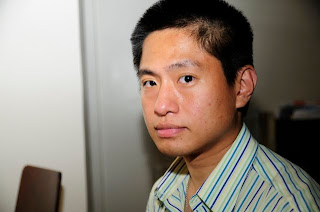
(One of my early shots utilizing some of Neil's techniques)
Below are a series of test shots showing Neil van Niekerk's innovative technique of using the "black foamie thing."
BACKGROUND:
When I first started learning about flash in 2007, I lucked upon Neil van Niekerk's Tangents blog and immediately became a fan. Up until then, I had known only about bouncing from ceilings. From Neil's flash tutorial, I learned to balance flash and ambient, and control the direction of my bounce. Little did I know that in my eagerness, I would miss one of Neil's key techniques.
One of Neil's innovations is the use of a sheet of black foam as a flag (a card to block light in one direction). I truly mean innovative because the foam sheet (in white) was originally popularized by abetterbouncecard.com as a larger bounce card. Neil however used it not so much to bounce light, but to block the light from the flash from hitting the subject, and he used a black foam sheet.
When I first read about Neil's black foamie thing, I didn't think it was an important technique. My impression was that it was an extravagant waste of flash power, inconvenient, and wouldn't be of much benefit. So I never tried it, being content merely to bounce with bare flash. I went so far as to make a black foamie thing, but never ever used it. Indeed, I even got highly retroreflective paper to augment the bounce efficiency of the bounce card, because I was still thinking of the foam sheet as a bounce card (instead of a flag).
Fast forward to 2009 when Neil published his book, On-Camera Flash
TEST SHOTS
The differences between bare, white flagged and black flagged are most apparent when the flash is being aimed to provide a short light. Note: I shot these test shots at sync speed to 'delete' the ambient (i.e., the light in these shots are virtually 100% flash) and I aimed the flash to a corner at camera left.
Bare flash (wide with diffuser):
Bare flash (zoomed):
White flag:
Black flag
As an experiment, I also tried increasing the efficiency of the black foamie by combining it with the white flag. The white interior would bounce flash more efficiently while the black exterior would hide direct light from the flag from reaching the subject.
Black and white flag:
The effect seems to be in between the white flag and the black flag, though closer to the white flag's effect. Side by side for comparison:
Neil also described using a headband to allow flexibility in positioning the black foamie thing. Here I tested the black foamie thing as a flag on the side of the flash.
Black flag on the side, flash at wide:
Black flag on the side, flash at zoom:
Needless to say, going forward, the black flag (or black and white flag) will be a technique that I will be using in my shots when possible. I have a lot of catching up to do...!








I'm glad you got this one, I did exactly the same as you, I thought he was using the black foam to bounce flash of it, not to shield.
ReplyDeleteIt was not until I went back and re-read ALL of his posts and ALL of the comments that I understood what was going on.
I have to say it is amazing how it works, especially with the new high ISO cameras, I use ISO 800 on my Canon 550D with zero noise reduction and the images look amazing, I might share some of my images with you if you like (we can even have a chat) but I don't like posting my family pictures on the internet.
One more thing you have to consider, your tests shots were all flash, no ambient, that's why you got dramatically variating results, I usually use this with ambient light where it makes even more sense than flash alone, I set my ambient exposure with a high enough shutter speed (1/80 for example) by adjusting the ISO, then I turn on my flash on TTL and adjust the FEC on the fly.
Waiting to read more of your articles, I like how you take things technically, I am on the opposite side where I usually try things without making thorough comparisons like you.
Good luck. :-)
Thanks mshafik! I have to thank you for encouraging me a while back to try out Neil's flag technique. (Otherwise, my poor black foamie would still be gathering cobwebs...)
ReplyDeleteThose Canon sensors are quite amazing aren't they. I'm always impressed by the low noise in them. I'm amazed that the recent batch of Canons have higher resolution than the Nikons but still have very low noise.
It would be great to see your photos and to share ideas! Please do email me at info @ betterfamilyphotos.com .
Have a good weekend and thanks again!
I just wanted to give you a heads up on a new "black foamie thing" on the market (not to SpinLight 360 by Neil van Niekerk). It's called the PRESSlite eclipse light shield. Their website is www.maxbounce.com and the features of this thing are very interesting. I am not at all affiliated with them but just thought you might be interested in these kinds of thing, since you understand what they do and how to break down the science.
ReplyDeleteKeep up your awesome blog!
Hi! Thank you very much. Funny enough, I was just looking at that last night. My issue with the eclipse is that it cannot rotate, so I'm not sure how well it works for certain angles.
DeleteBTW, in case you haven't seen it, check out this post on DIY spinlight alternatives:
Option 1: http://betterfamilyphotos.blogspot.com/2012/07/testing-diy-spinlight.html
Option 2: http://betterfamilyphotos.blogspot.com/2012/07/flashright-pro-as-spinlight-360.html
Thanks for your continued support of our blog.
Best regards,
Mic
Mic,
DeleteI've been using the eclipse for a month now and can tell you this thing covers all the angles pretty well. In other words, there wasn't a time I had to rotate it for any reason. Have you checked out their animated videos that show the coverage of the eclipse?
https://www.youtube.com/watch?v=jMZT4oaVmsA
https://www.youtube.com/watch?v=9TMU-URV4m0
Your DIY versions of the SpinLight are impressive. SpinLight is going to have problems selling it for $100+ dollars with your DIY alternatives. How heavy are your DIY spinlights? I read that the 360 is over 9 ounces!
Maybe you can figure out a DIY version of the eclipse for cheap.
Brett
Hi Brett. Thanks for letting me know about your experience using the eclipse.
DeleteThe version of the diy spinlight that has a rubber mount is a little on the heavy side. Don't know the exact weight, but the flash head barely holds it up at a tilted angle.
The other version of the diy spinlight (based on the flashright) is not heavy.
As for a diy eclipse it looks very easy to make out of foam rubber. I might do that one of these days to test.
Thanks!
Best regards,
Mic